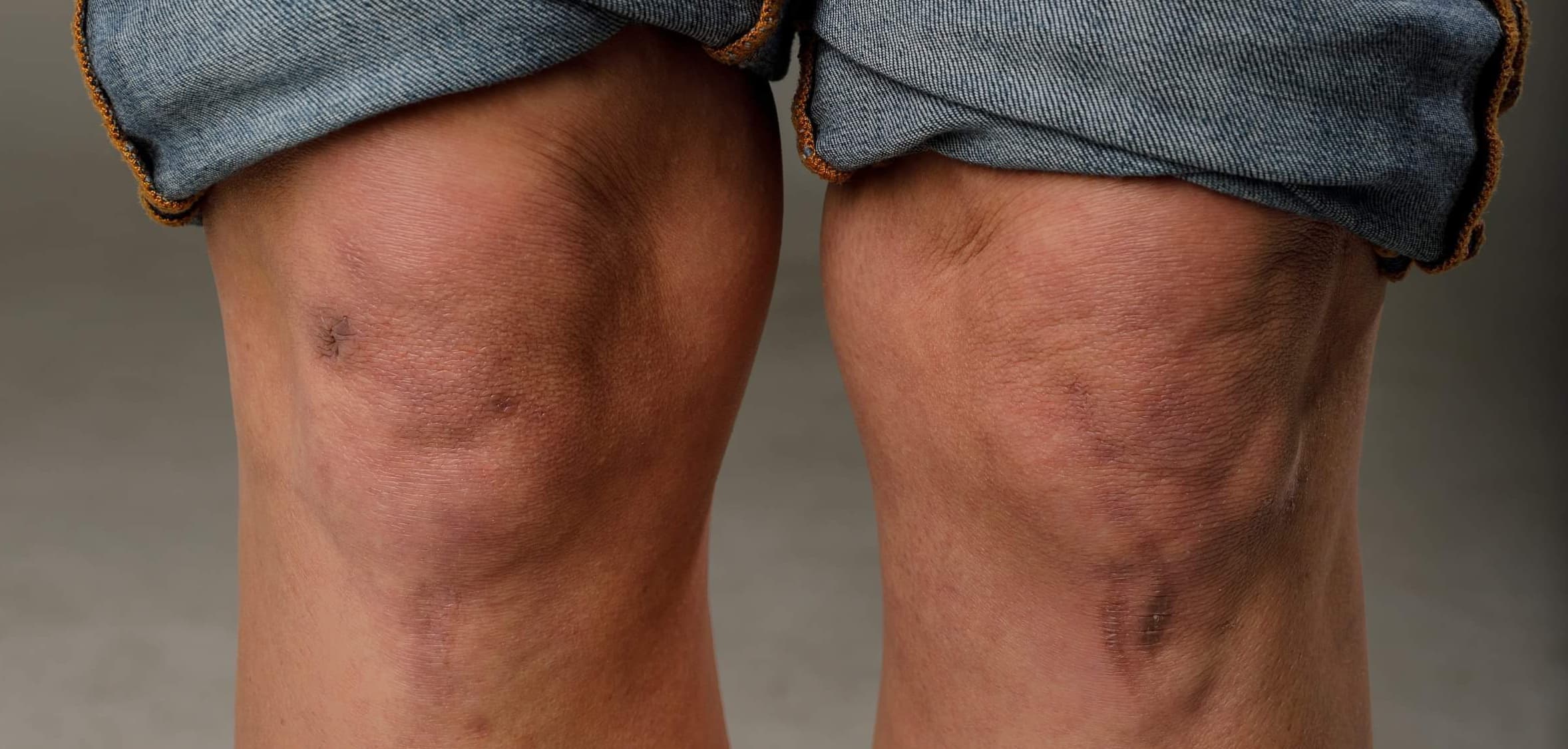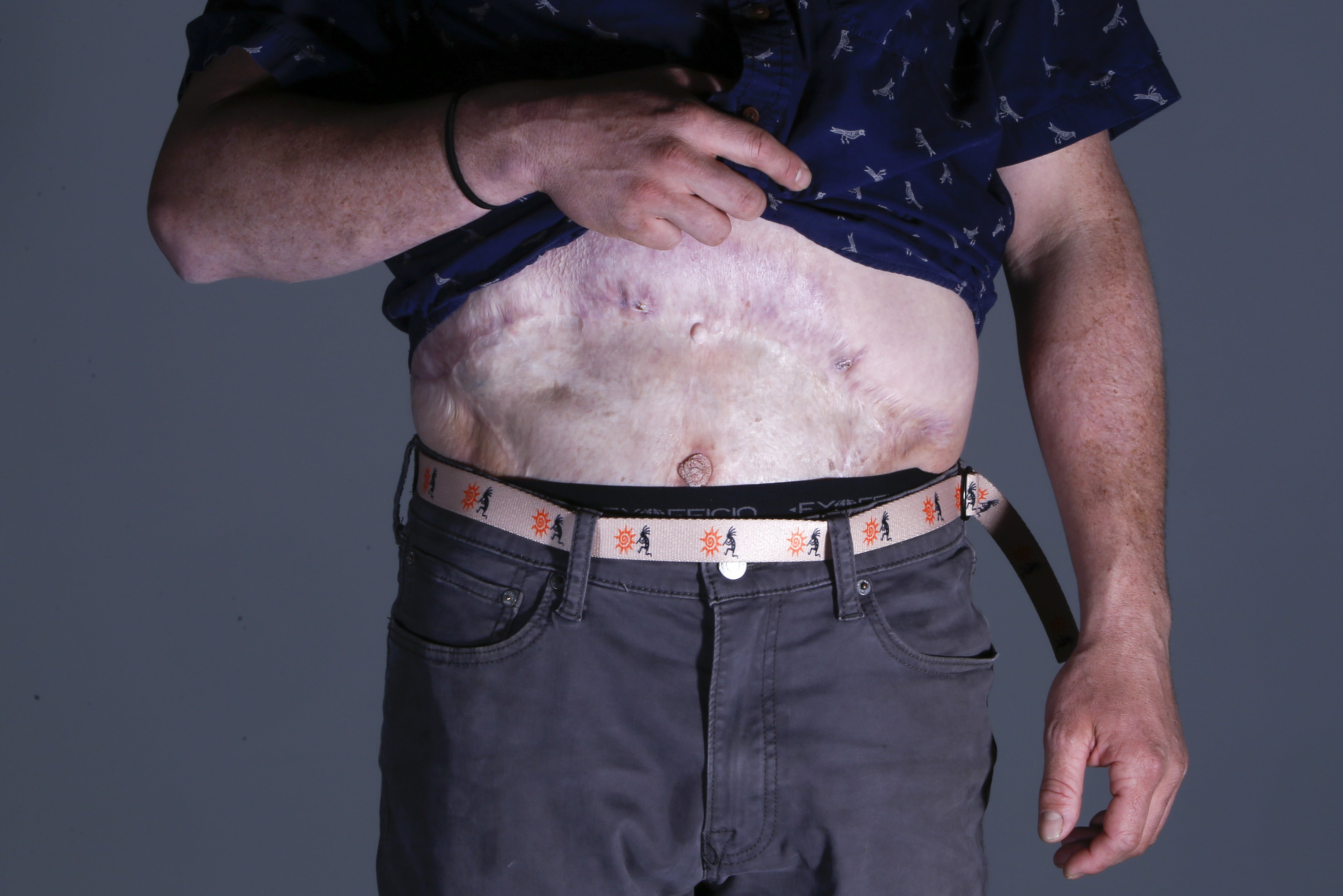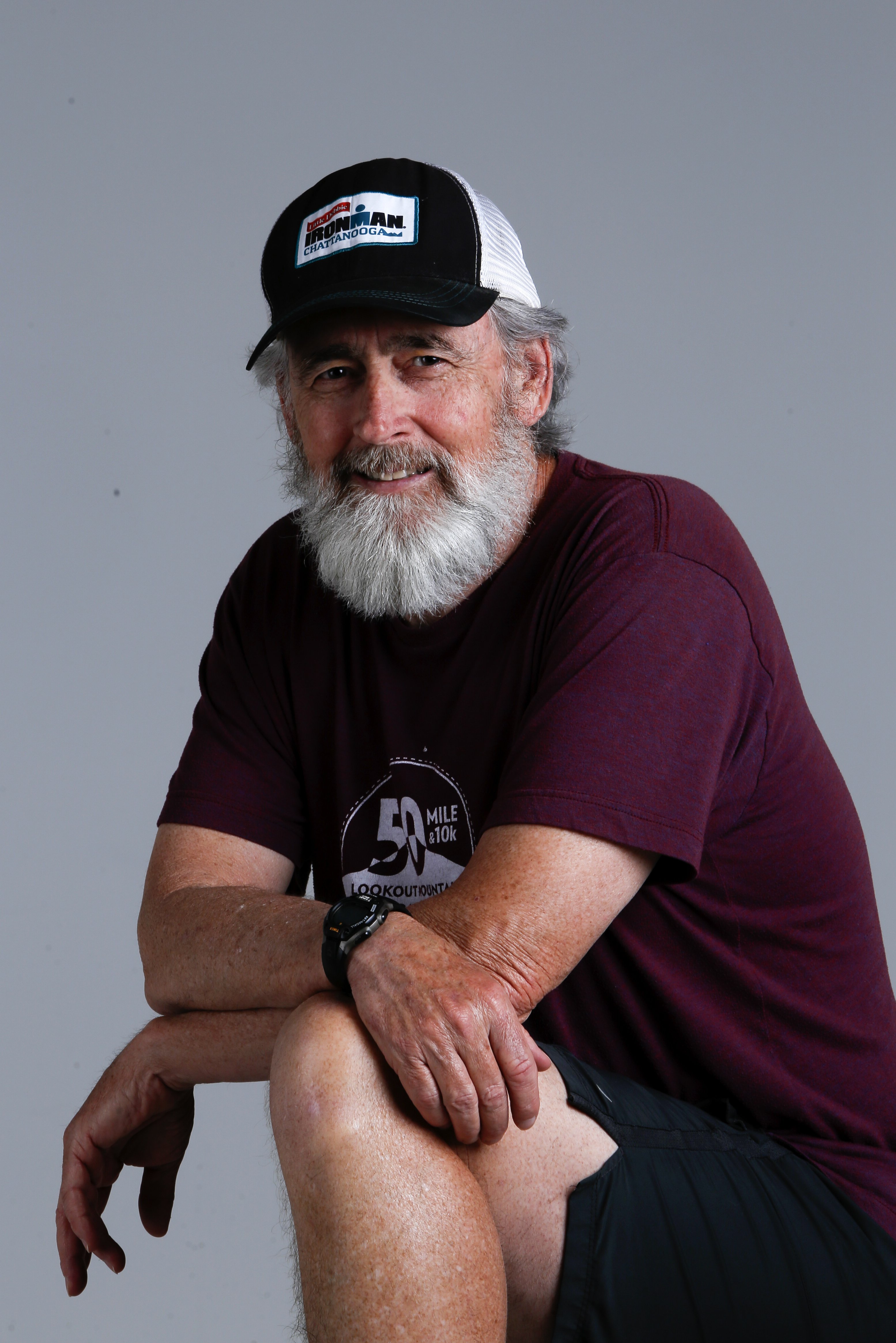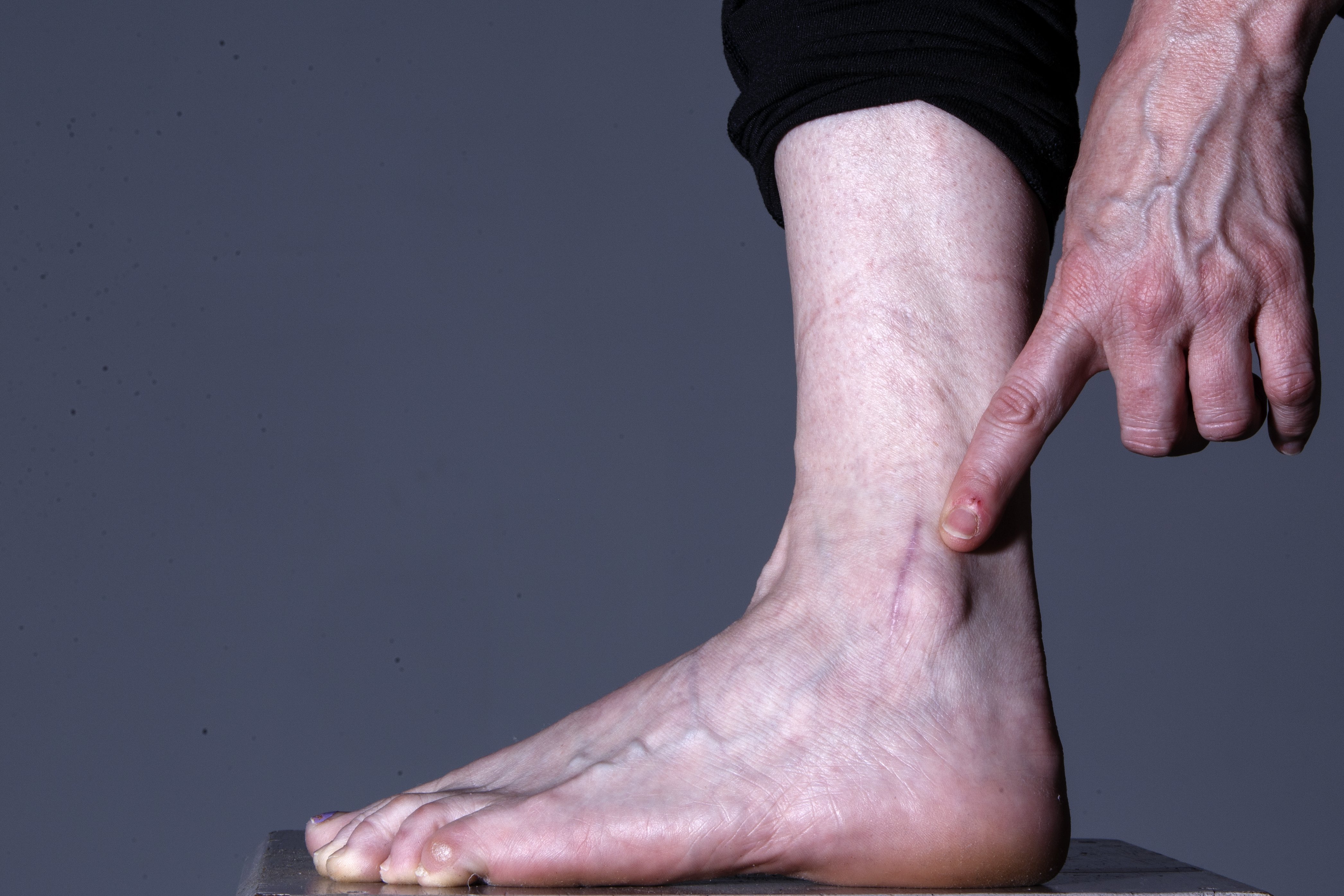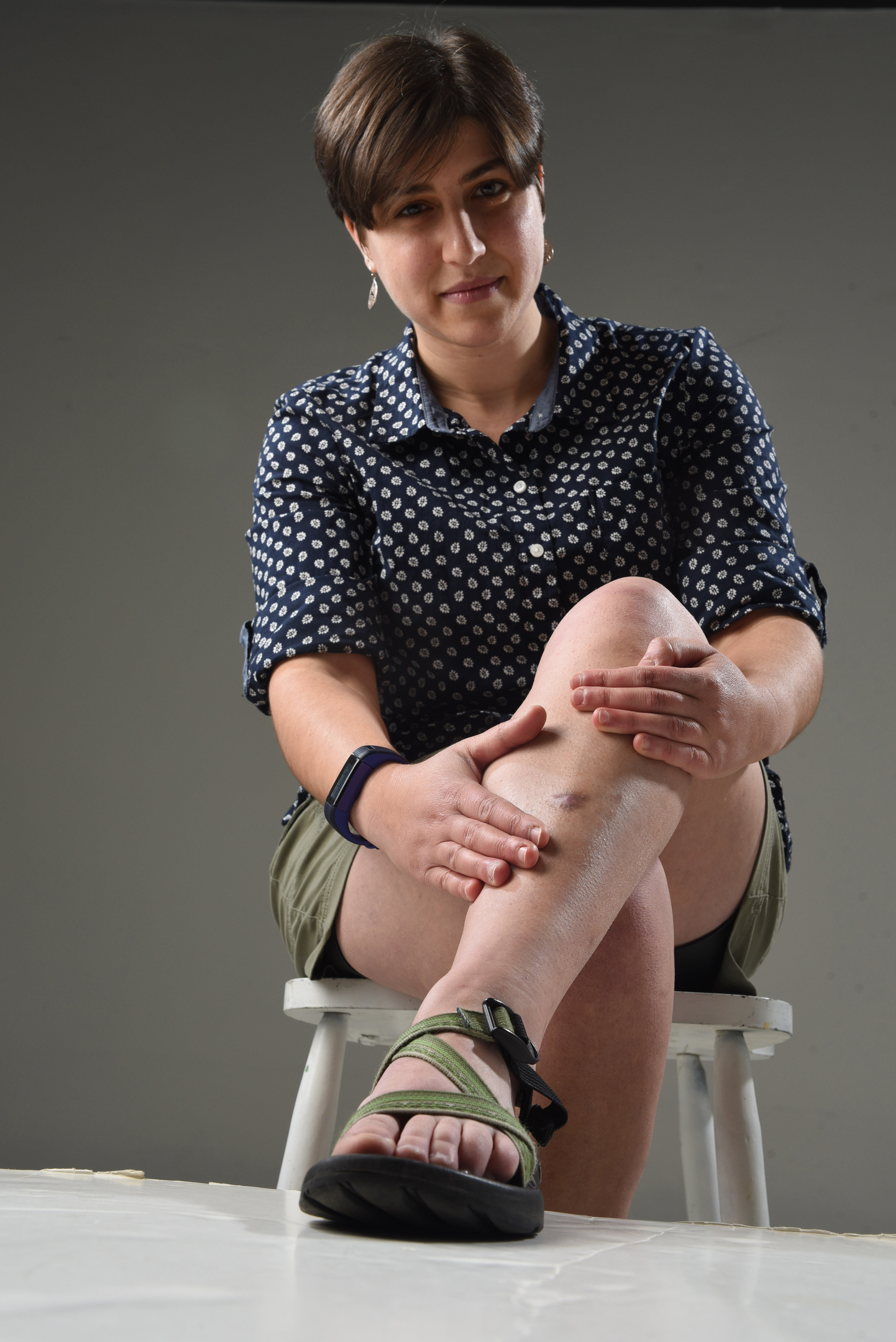Outdoorspeople love to talk about their scars. And why wouldn't they? A scar, after all, is evidence of one's unyielding commitment to his or her craft, made only more meaningful by its permanence.
Besides, scars come with cool stories - and, often, important lessons. Don't run while peeling fruit, for example. Or, think twice before getting those stitches.
Here, local cavers, runners, paddlers and mountain bikers share their scar stories.
_____
Ann-Marie Fitzsimmons began collecting knee scars during the 2017 Fall Creek Falls Triathlon.
Fitzsimmons, 44, was on her road bike, pedaling uphill when she came to a railroad crossing. A train parked on the track had triggered the signal, causing the crossing arm to start to lower. She thought she had time to brake and unclip her shoes from her pedals.
"But I didn't unclip in time. And boop. I fell over," say Fitzsimmons, who, as a result of that accident, now sports a small purple scar below her right kneecap.
Her second injury, also to her right knee, happened four months later when she fell on a rock at mile 13 of a 20-mile Lookout Mountain training run.
"I was peeling an orange and running at the same time. I ended up having to finish that run covered in blood," Fitzsimmons says.
Later that year, while competing in Lenoir City's Firewater 100k trail race, she slipped on some pine needles, thus acquiring scar No. 3, this time on her left knee.
When she got to the next aid station, the volunteer there tried to convince Fitzsimmons to go get stitches. But she had already been running for seven hours. She was at the halfway mark.
"You train hard for a 100k. You're not going to quit just because you need stitches," Fitzsimmons says. "I finally told him, 'Sir, I've given birth to five children. I'll be fine. I'm finishing this race.'"
So she doused her wound in liquid bandage and, 10 hours later, she crossed the finish line.
Her collection of knee scars, she says, helps remind her of the lessons she's learned on the trail.
For example, she says, "Walk while you peel an orange." But, more importantly, "Do what you love."
_____
One summer afternoon, when Danny McSpadden was 13, he and his friends went mountain biking in Soddy-Daisy. The steep trails were overgrown with privet, so McSpadden used a machete to cut back the branches - incidentally turning those branches into sharp spears.
"At the bottom of the trail, I hit mud, spun out and landed on one," says McSpadden, now 31.
The pencil-shaped stick went into his knee and out the other side. Later, at the emergency room, McSpadden underwent a 12-hour surgery to have it removed - though the scar from that surgery is no longer visible.
"It's covered up in burn scars now," McSpadden says.
At age 20, McSpadden was working as a lineman when a 72,000-volt power line fell on him.
"I thought it was a dream. It felt so surreal. I immediately lost all feeling. What I remember most, honestly, is the smell of cooking skin," he says.
Third- and fourth-degree burns covered 45% of his body. He spent the next five months at Vanderbilt Medical Center, undergoing a total of 17 blood transfusions and too many surgeries too count, making that surgery of his childhood seem like a cinch.
"They had to rebuild me. I have no abdominal muscles. I can't even do a sit-up," he says.
But he can still mountain bike. Thanks to years of physical therapy - and the surgical mesh lining his abdominal wall - today, McSpadden is a black-diamond-level mountain biker, and a Class V kayaker. He says he knows that an extreme lifestyle is riskier for him than most. But the months he spent confined in that hospital only strengthened his lifelong passion for the outdoors.
"It drove me to be outside," he says.
_____
Billy Collier, a 66-year-old triathlete and ultrarunner, refers to his big scar-inducing incident as "The Gash."
It occurred in 2016 during the Rock/Creek StumpJump, a grueling 50k trail race through Prentice Cooper State Forest. That year, however, Collier was not a competitor. Ironically, he was a volunteer at the first aid station.
The morning of the race, he arrived at 6 a.m. to begin setup. It was still dark as he unloaded water jugs from his car parked along Suck Creek Road, which intersects the course. Where the trail crosses the road, a sign bolted to the guard rail reads "Watch for Runners."
When Collier went to climb over that rail to continue up the steep trail to his station, he impaled his shin on one of the sign's bolts.
"It went pretty deep. I had to pull my leg off it. I thought, 'Yeah, it's kind of bad,' but I didn't want to ruin my Saturday sitting in a hospital," he says.
So he continued to haul water up the trail. Eventually the sun came up, illuminating his injury. A forest ranger approached him.
"I guess he noticed the blood and the meat hanging out," says Collier, who, at the ranger's urging, finally bandaged his wound.
Following the race that afternoon, Collier did visit a doc-in-the-box, where he received 11 stitches.
"I've just had enough injuries on the trail," Collier says of his nonchalance.
Once, for example, he fell while running and broke his wrist. He waited a week to see a doctor about that. Another time, he fell and hit his head.
"Just a minor brain injury," Collier says. "I've never really had an injury that slowed me down."
_____
When Amber Lehmann broke her leg on the trail, her immediate reaction was not to panic but, rather, to get angry.
"I was like, 'This is going to disrupt my whole life!' Then I immediately went into, 'OK, now how am I going to get down this mountain?'" says the 45-year-old local caver.
That day, Lehmann and two friends had been hiking up a steep, rocky slope in search of a cave near Jasper, Tennessee.
"We had GPS coordinates, but we couldn't find the entrance," Lehmann says.
While scouting, Lehmann climbed onto a narrow shelf choked with tree roots. Carefully, she started to shuffle across the rock, but her left foot got caught beneath one of the roots. Then, she lost her balance.
"I had a 30-pound gear bag on my back, so when I fell I fell like a sack of potatoes. I heard my bone crack," she remembers. She began to whistle to her friends, about 100 feet away.
"They heard me and were like, 'Oh! You found the cave!' I was like, 'No, I broke my ankle,'" says Lehmann.
Her friends wanted to call the Southeast regional coordinator for the National Cave Rescue Commission - who also happens to be Lehmann's husband.
But Lehmann was adamant. "No," she told them, "'you're not sending a rescue crew to haul me off this mountain.' They would have had to come out here, put me on a sked, tie me down and rig a high line to get me down."
So she began to scoot, butt to the ground and broken leg to the sky. She scooted the half-mile down the mountain, through a shallow stream and into the back of her friend's Land Rover.
"I'm covered in mud and leaves and soaking wet. So when we get to the hospital, I'm like leaving a trail of debris through the halls," Lehmann says.
There, an X-ray confirmed that she had, in fact, broken her fibula, or calf bone. The injury would require surgery, one plate, six screws, 12 stitches and a 13-week recovery period.
"It didn't change the way that I cave, but it did change how I think about being outdoors," Lehmann says. "I take more precautions now. Like, trekking poles are a huge help."
_____
When Paul-Erik Bakland was 12, his family moved from a Southern California suburb to middle-of-nowhere Montana. Their new home sat on a hilly, three-acre farm - prime real estate for a boy who loved to tear around on his dirt bike.
Early one evening, Bakland was out on his bike, zipping up and over the golden hills, squinting against the low sun.
"It wasn't that the sun was in my eyes, it's just that the way it was shining, I couldn't see the barbed wire fence until it was too late," says Bakland, now 32.
The instant he realized he was barrelling toward the fence, he panicked and tried to jump off his bike.
"My whole body got the message except for my hands, so I ended up throttling the bike, and that caused me to crash into the fence even harder," Bakland says.
When he came to on the other side of the fence, he stood up. "That's when I felt my chest starting to get wet," says Bakland.
He reached up, touched his throat and found blood - lots of it. His parents heard his screams as he ran toward the house and met him halfway.
"When my mom took off my helmet to get a better idea of what she was dealing with, her face went white," Bakland remembers.
Within minutes, the family was in the car and speeding toward the emergency room, where Bakland would see his injury for the first time.
"They put me under the X-ray machine with this long triangular pillow under my neck. I caught a reflection of myself in the machine. I could see inside my neck and I just about passed out," he says.
The barbed wire had torn Bakland's throat open almost ear to ear, ultimately requiring more than 60 stitches. Had he been going 1 to 2 miles per hour faster, the doctor told his family, the impact would have severed his carotid artery, causing him to bleed out.
On his way home from the hospital, Bakland remembers asking his parents, "Are you going to take away my dirt bike now?"
"We'll talk about it," his mother had said.
Eventually, Bakland did get back on his bike. Though, he says, "I stayed away from the part of the farm where it happened. I never went there again.
"I'll tell you, it wasn't the physical recovery I remember; it was the emotional recovery. I definitely became acutely aware of my own mortality after that."
_____
Meryl Stark points to a small purple scar on her left shin and says, "This is a $25,000 cut."
Last August, Stark, 29, was kayaking on the Ocoee River when her friend flipped in a rapid, resulting in a swim. To help, Stark pulled into a nearby eddy, climbed out of her kayak and started across some rocks toward her friend - when Stark slipped and smacked her shin on a sharp rock.
"I looked at [my shin] once and I knew I didn't want to look at it again," she says. Stark's friend took one look, too, and told her, "Yeah, that's gonna need stitches."
So, swallowing her lifelong fear of needles, as soon as Stark was off the river, she headed to an urgent care center, where she received nine stitches and a bottle of antibiotics.
The next day, the pain was excruciating, Stark says. The day after that, it was worse.
"I was trying to be human and I couldn't. I couldn't drive. I could barely walk. I didn't know if it was because I'd whacked it so hard or if it was infected," she says.
Finally, Stark's friends convinced her to go to the emergency room.
"From the very beginning, my fear was to end up in the ER hooked to IVs with some crazy infection," Stark says. "And then that's exactly what happened."
At the hospital, she was admitted and diagnosed with a bacterial infection - which, she learned, had been made worse by the stitches, which now had to be surgically removed so her infection could drain.
"If I hadn't gotten stitches, it would have still gotten infected, it just wouldn't have built up like that and become a 'hospitalization' level infection," says Stark.
The injury ultimately cost her a total of four days in the hospital, 11 rounds of antibiotics and, of course, a $25,000 medical bill.
But the scariest part of the ordeal, she says, was the hospitalization itself. "It was all new to me. I was losing my shit, screaming about needles. I felt like I was laying there waiting for the vampire to come," she says. But the experience did teach her two valuable lessons.
"I know now I can make it through really scary things," Stark says. "Also, I'm now the first person to tell people, 'Don't get stitches!'"


